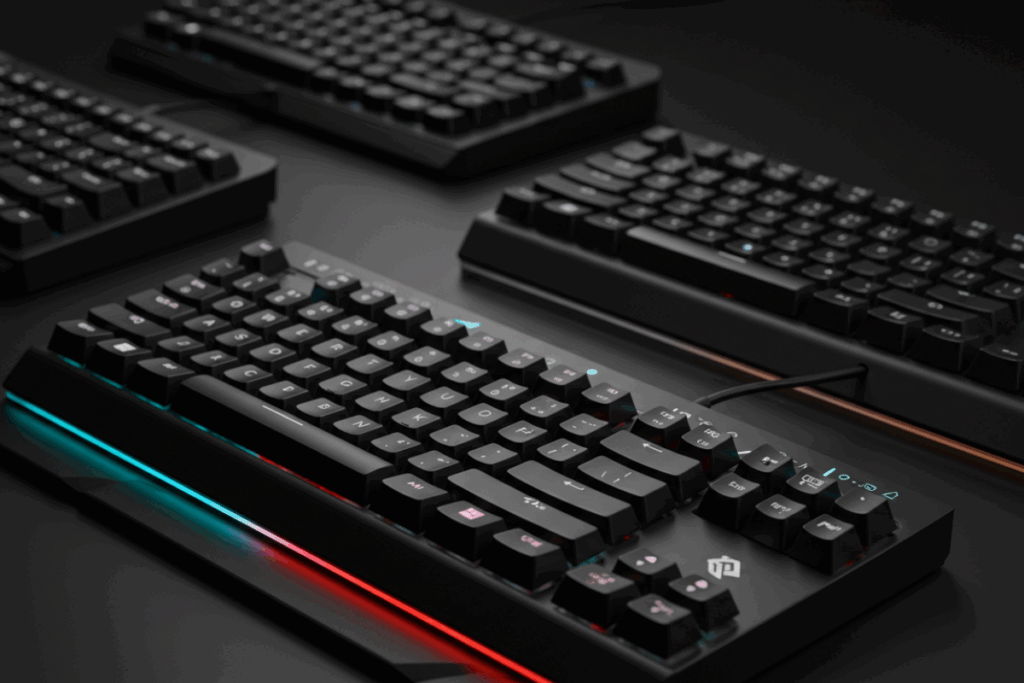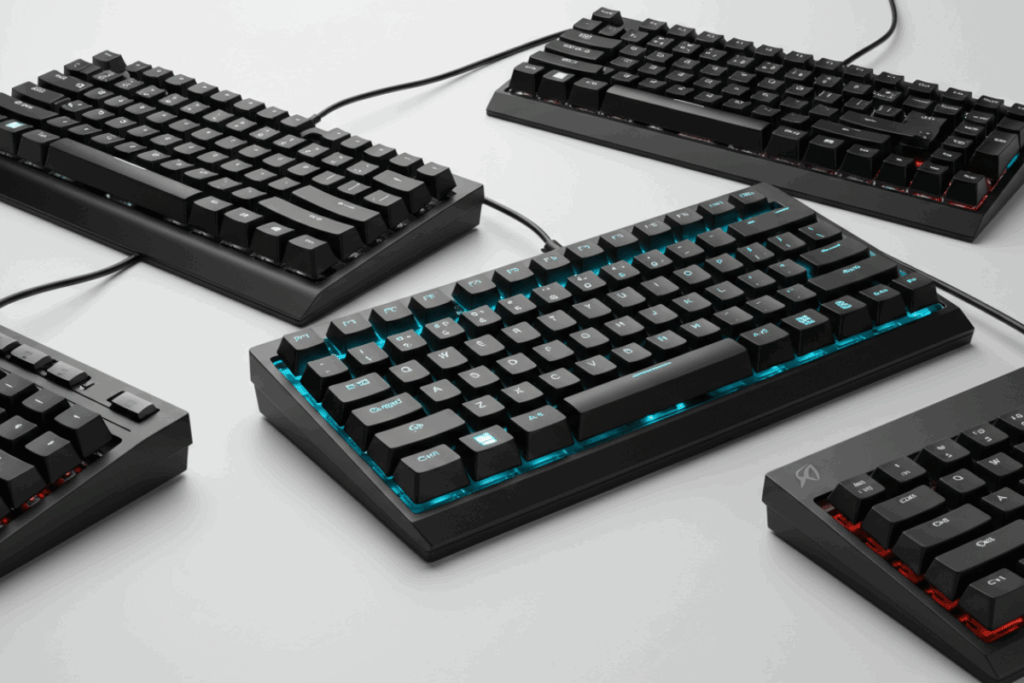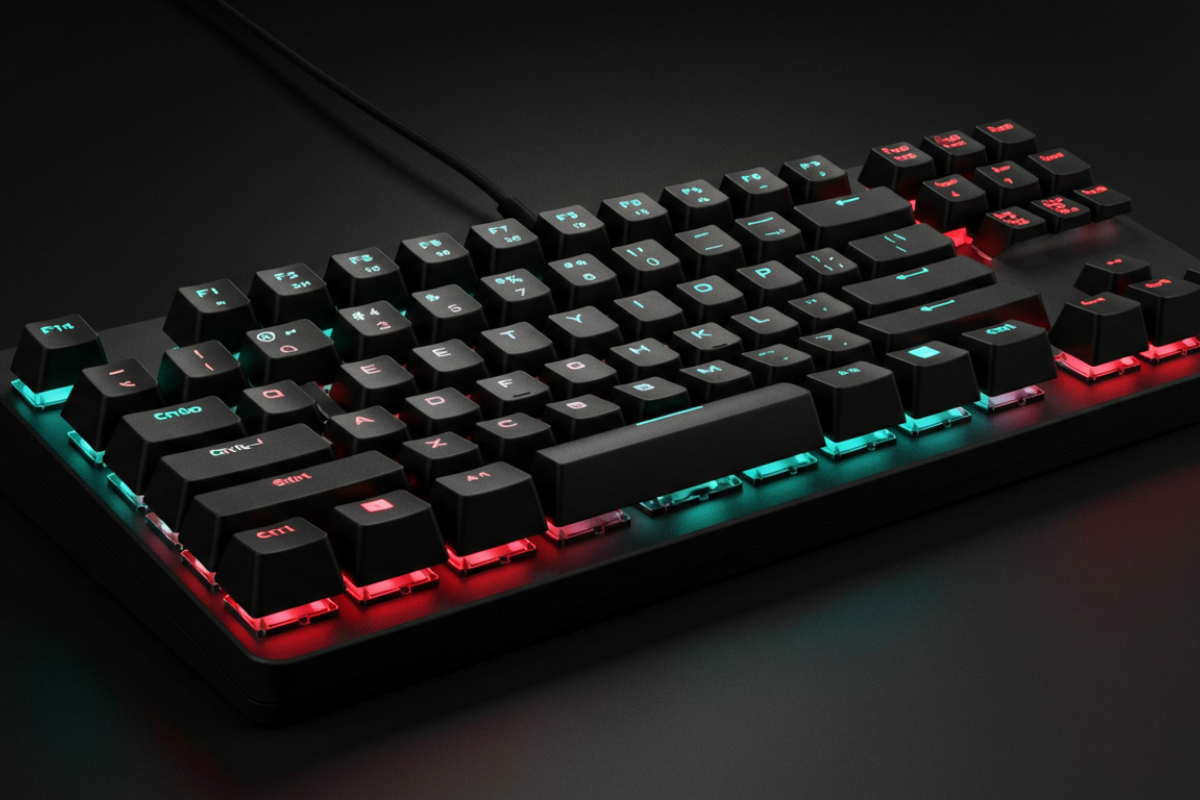best low profile keyboards are my obsession at Keyboards Technology. This hands-on guide shows how I pick winners for speed, comfort, looks, and long-term use. I test for faster actuation, short travel, the right wrist angle, and the best switch types (low-profile mechanical, optical, and scissor).
I weigh wired versus wireless trade-offs, check backlighting, polling, macros, and build strength, then run latency, durability, and real-game tests to see what truly performs.
Key Takeaway
- I pick boards that deliver quick key response and less finger fatigue.
- A good low-profile board improves wrist angle and comfort for long sessions.
- Low-latency wired and 2.4 GHz wireless options are essential for competitive play.
- I value hot-swap, PBT keycaps, and compact layouts for customization and portability.
- Slim builds with quiet feel and sturdy parts suit tournaments and travel.
Why I Choose the Best Low Profile Keyboards for Gaming
Faster actuation & shorter travel
Low-profile designs give faster actuation and short travel, which shave milliseconds off inputs—critical in clutch FPS moments.
Quick switch comparison I test:
| Switch type | Typical actuation (mm) | Total travel (mm) | Feel |
|---|---|---|---|
| Low-profile mechanical | ~1.0–1.5 | ~3.0–3.2 | Crisp, fast |
| Scissor | ~1.5–2.0 | ~2.0–2.5 | Stable, low wobble |
| Slim membrane | ~1.8–2.2 | ~2.5–3.0 | Soft, quiet |
I prioritize actuation distance, travel, and low latency (high polling, low input lag). The combo feels like switching from a hiking boot to a sprint shoe.
Ergonomics & wrist angle
Comfort beats flashy lights. I look for low top height, gentle key angles, adjustable tilt, low keycap profile, and a padded wrist rest. A low-profile board helps keep wrists neutral and reduces soreness.
Portability & desk aesthetics
I travel with compact boards—60% and TKL layouts save space and are lighter. A slim keyboard plus tidy cable routing gives a minimalist, focused desk setup.
How I Evaluate Features When Picking the Best Low Profile Keyboards
I treat keyboards like running shoes: comfort first, performance next. I test each model in real play and everyday typing, logging the clear trade-offs.
Switch types I test
I try low-profile mechanical, optical, and scissor switches for hours and score on actuation, travel, feel, and durability.
| Switch | Feel | Pros | Cons | Best for |
|---|---|---|---|---|
| Low-profile mechanical | Tactile or linear | Fast, durable, often hot-swap | Slightly louder, pricier | Competitive gamers, typists |
| Low-profile optical | Very fast, smooth | Ultra-low latency, long life | Fewer tactile options | Pro gamers |
| Scissor / laptop | Quiet, stable | Thin, cheap, long battery | Less satisfying for long typing | Office, travel, casual gaming |
Wired vs wireless trade-offs
Connection must be reliable. For competitive play I prefer wired; for clean desks and portability I use 2.4 GHz or Bluetooth depending on needs.
| Connection | Latency | Battery | When I pick it |
|---|---|---|---|
| Wired (USB) | Lowest, steady | No battery | Tournaments, competitive play |
| 2.4 GHz dongle | Very low (near-wired) | Hours–days | Home gaming with tidy setup |
| Bluetooth | Higher, variable | Long idle life | Casual, multi-device use |
I test battery drain under load (RGB on, macros active) and always carry a backup cable for long sessions.
Lighting, polling, macros, software & build
- Backlighting: I test per-key and zone RGB for brightness and bleed.
- Polling rate: I look for 1000 Hz on wired gear.
- Macros & onboard memory: Onboard profiles are important so settings travel with the board.
- Software: Local, stable firmware wins. Cloud-only remaps are a negative.
- Build: Aluminum top plates feel solid; thin plastic flexes. I test stabilizers for rattle.
I favor boards balancing speed, comfort, and reliability, and I flag hot-swap and PBT keycaps as longevity features.

Comparing Low-Profile Switches I Recommend
Low-profile mechanical (Cherry MX Low Profile, Kailh Choc)
Both provide fast feel with reduced height. Key specs I watch: actuation point, travel, force, polling, NKRO, and build (metal vs plastic).
| Switch | Actuation | Travel | Force | Best for |
|---|---|---|---|---|
| Cherry MX Low Profile (Red/Brown) | ~1.2 mm | ~3.2 mm | ~45 cN | Fast FPS, mixed typing |
| Kailh Choc (Red/Brown) | ~1.5 mm | ~3.0 mm | ~35–50 cN | Slim boards, esports |
Low-profile optical & scissor
Optical boards offer very low latency and long life; scissor switches excel in thin laptops and battery life but lack deep tactile feedback.
Key checks: latency (USB vs 2.4 GHz vs BT), battery life, programmability, onboard memory, and keycap material (PBT preferred).
My top switch picks for FPS & typing
| Pick | Actuation | Force | Type | Why |
|---|---|---|---|---|
| Cherry MX Low Profile Red | ~1.2 mm | ~45 cN | Linear | Fast, twitchy aiming |
| Kailh Choc Red | ~1.5 mm | ~35–40 cN | Linear | Light, quick presses |
| Cherry MX Low Profile Brown | ~1.2 mm | ~45 cN | Tactile | Balance of gaming typing |
| Low-profile optical linear | ~1.0–1.5 mm | Varies | Optical | Lowest latency on USB/2.4 GHz |
Tip: Pair linear low-profile switches with solid stabilizers and PBT keycaps to avoid hollow feel. For the best low profile keyboards, prioritize models that list measured actuation and travel.
My Performance Testing Checklist
Measuring input latency & polling
I measure end-to-end input latency using a high-speed camera and USB packet tools, and verify polling rate (125 / 250 / 500 / 1000 Hz). I record latency for wired, 2.4 GHz, and Bluetooth.
What I measure:
- End-to-end latency (ms) — high-speed camera
- Polling rate (Hz) — firmware/software readout
- Actuation point & total travel (mm) — calipers and spec check
Durability metrics
I log rated keystrokes (50M, 80M, 100M), MTTF, run stress scripts on common keys (WASD, space), and track stabilizer behavior and case wear. I keep a durability log per model.
Real-world impressions
I play hours of FPS, MOBA, and typing tests. I check:
- Tap crispness, double-tap consistency
- Macro reliability and NKRO behavior
- Typing comfort, WPM, and noise
- Keycap legend wear
Pass signs: no missed taps, reliable macros, stable WPM, and solid stabilizers.
Top Picks Among Best Low Profile Keyboards by Category
Best overall / budget / affordable
For best overall I look for: actuation ~1.0–1.2 mm, travel 3.0–3.5 mm, low-profile mechanical switches, 1 ms wired, full NKRO, and aluminum top.
For budget, prioritize core feel and low latency—scissor or budget low-profile mechanicals with USB-C wired and simple backlight.
For affordable, look for PBT keycaps, 1000 Hz polling, and TKL options.
| Category | Key specs |
|---|---|
| Best overall | Actuation 1.0–1.2 mm, travel 3.0–3.5 mm, 1 ms, NKRO, aluminum top, per-key RGB, hot-swap |
| Best budget | Actuation 1.2–1.6 mm, travel 2.8–3.5 mm, USB-C, zone RGB |
| Affordable | PBT keycaps, 1000 Hz polling, TKL option |
Wireless & RGB options
For wireless competitive play expect 2.4 GHz dongle with ~1–4 ms latency. Aim for 40 hours battery with RGB off, and 8–20 hours with bright RGB. For RGB-focused boards want per-key lighting, profiles, and responsive effects.
| Option | Connectivity/latency | Battery | Lighting |
|---|---|---|---|
| Wireless competitive | 2.4 GHz, ~1–4 ms | 40 hrs (no RGB) | Basic zones or off |
| Wireless multi-device | Bluetooth dongle | 20–60 hrs | Per-key RGB possible |
| RGB-focused | Wired <1 ms; Dongle ~1–4 ms | Wired unlimited; Wireless 8–40 hrs | Per-key RGB, profiles |
Quick tips:
- For low latency: plug in.
- For desk looks: per-key RGB PBT caps.
- For travel: aim for actuation ~1.0–1.4 mm.
TKL & compact picks
TKL for competitive play (arrows space), 60%/65% for portability and minimalist desks. Both should have consistent stabilizers, PBT keycaps, and 1000 Hz polling.
| Layout | Who it’s for | Must-have |
|---|---|---|
| TKL | FPS players who want arrows | NKRO, sturdy frame |
| 60% / 65% | Portable/minimalist | Layered keys, hot-swap |
How I Choose and Maintain a Low Profile Keyboard
Picking form factor
Choose based on desk space and play style:
- Full-size: work gaming
- TKL: saves desk space, competitive gaming
- 75%/65%/60%: compact, fast hand travel
- Split: ergonomic for long sessions
I use a 65% low-profile for quick movements and a TKL for practice days.
Maintenance routine
- Keycap cleaning: remove and soak in warm soapy water monthly.
- Firmware updates: check Keyboards Technology for improvements; backup profiles.
- Stabilizer care: add small lubricant to stems/housings to remove rattle.
Maintenance table:
| Task | Frequency | Tip |
|---|---|---|
| Keycap wash | Monthly or when sticky | Use soft brush; avoid hot water |
| Firmware | When released | Save profiles before flashing |
| Stabilizer lube | Every few months | Small amount; test before closing |
Setup tweaks for ergonomics & performance
- Keep the keyboard flat or slightly tilted down for neutral wrists.
- Choose low-profile mechanical or scissor switches for gaming.
- Set polling to 1000 Hz when possible.
- Map less-used keys to layers to shorten travel.
- Place the board close to the mouse to reduce hand travel.
Small setting changes can feel like a hardware upgrade.

Conclusion
I pick best low profile keyboards for speed, comfort, and reliability. Look for short actuation, tight travel, solid polling (1000 Hz wired), and a stable case. Wired gives lowest latency; 2.4 GHz is the best cordless compromise; Bluetooth is for convenience. Prefer low-profile mechanical or optical for esports, and scissor for travel and quiet typing. Hunt for hot-swap, PBT keycaps, and good stabilizers—those extend a board’s useful life.
Maintenance and setup matter: a quick clean, firmware check, and stabilizer lube can make a good keyboard great. Choose the form factor that fits your desk and play style—TKL for competitive space, 65%/60% for portability—and tune angle and polling to match your posture and goals.
Frequently Asked Questions
Q: What are the best low profile keyboards for gaming?
A: I recommend models that combine short actuation, 1000 Hz polling, low-profile mechanical/optical switches, and solid build—those deliver the best competitive performance.
Q: Why choose a low-profile keyboard for gaming?
A: Faster actuation and reduced travel let you react quicker and reduce wrist strain during long sessions.
Q: Are low-profile mechanical switches durable for heavy gaming?
A: Yes—many are rated for tens of millions of presses. Look for clear rated keystrokes and solid build.
Q: Wired or wireless — which is best?
A: Wired is best for the lowest latency. Use 2.4 GHz wireless for near-wired performance with cable-free convenience.
Q: Can I get macros and RGB on the best low profile keyboards?
A: Absolutely. Many top low-profile boards offer per-key RGB, onboard profiles, and reliable macro support.

